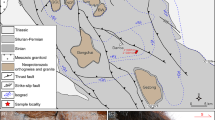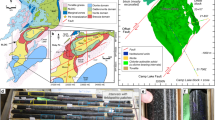Abstract
The new mineral species lavoisierite, ideally Mn2+ 8[Al10(Mn3+Mg)][Si11P]O44(OH)12, has been discovered in piemontite-bearing micaschists belonging to the Piedmontese Nappe from Punta Gensane, Viù Valley, Western Alps, Italy. It occurs as yellow-orange acicular to prismatic-tabular crystals up to a few millimeters in length, with white streak and vitreous luster, elongated along [010] and flattened on {001}. Lavoisierite is associated with quartz, “mica,” sursassite, piemontite, spessartine, braunite, and “tourmaline.” Calculated density is 3.576 g cm−3. In plane-polarized light, it is transparent, pleochroic, with pale yellow parallel to [010] and yellow-orange normal to this direction; extinction is parallel and elongation is positive. Birefringence is moderate; the calculated average refraction index n is 1.750. Lavoisierite is orthorhombic, space group Pnmm, with a 8.6891(10), b 5.7755(3), c 36.9504(20) Å, V 1854.3(2) Å3, Z = 2. Calculated main diffraction lines of the X-ray powder diffraction pattern are [d in Å, (I), (hkl); relative intensities are visually estimated]: 4.62 (m) (112), 2.931 (vs) (1110), 2.765 (s) (1111), 2.598 (s) (310), 2.448 (ms) (028). Chemical analyses by electron microprobe give (in wt%) P2O5 2.08, V2O5 0.37, SiO2 34.81, TiO2 0.13, Al2O3 22.92, Cr2O3 0.32, Fe2O3 0.86, Mn2O3 6.92, MnO 19.09, MgO 5.73, CaO 1.94, Na2O 0.01, H2O 5.44, sum 100.62 wt%. H2O content was calculated from structure refinement. The empirical formula, based on 56 anions, is (Mn 2+5.340 Mg1.810Ca0.686Na0.006)Σ=7.852(Al8.921Mn 3+1.739 Mg1.010Fe 3+0.214 Cr0.084Ti0.032)Σ=12.000(Si11.496P0.582V0.081)Σ=12.159O43.995(OH)12.005. The crystal structure of lavoisierite was solved by direct methods and refined on the basis of 1743 observed reflections to R 1 = 4.6 %. The structure is characterized by columns of edge-sharing octahedra running along [010] and linked to each other by means of [SiO4], [Si2O7], and [Si3O10] groups. Lavoisierite, named after the French chemist and biologist Antoine-Laurent de Lavoisier (1743–1794), displays an unprecedented kind of structure, related to those of “ardennite” and sursassite.


Similar content being viewed by others
References
Allmann R (1984) Die Struktur des Sursassits und ihre Beziehung zur Pumpellyit- und Ardennitstruckur. Fortschr Mineral Beiheft 62:3–4
Allmann R, Donnay G (1971) Structural relation between pumpellyite and ardennite. Acta Crystallogr B27:1871–1875
Allmann R, Donnay G (1973) The crystal structure of julgoldite. Mineral Mag 39:271–281
Artioli G, Geiger CA (1994) The crystal chemistry of pumpellyite: an X-ray Rietveld refinement and 57Fe Mössbauer study. Phys Chem Miner 20:443–453
Artioli G, Pavese A, Bellotto M, Collins SP, Lucchetti G (1996) Mn crystal chemistry in pumpellyite: a resonant scattering powder diffraction Rietveld study using synchrotron radiation. Am Mineral 81:603–610
Artioli G, Geiger CA, Dapiaggi M (2003) The crystal chemistry of julgoldite-Fe3+ from Bombay, India, studied using synchrotron X-ray powder diffraction and 57Fe Mössbauer spectroscopy. Am Mineral 88:1084–1090
Barresi A, Orlandi P, Pasero M (2007) History of ardennite and the new mineral ardennite-(V). Eur J Mineral 19:581–587
Brese NE, O’Keeffe M (1991) Bond-valence parameters for solids. Acta Crystallogr B47:192–197
Brigatti MF, Caprilli E, Marchesini M (2006) Poppiite, the V3+-end-member of the pumpellyite group: description and crystal structure. Am Mineral 91:584–588
Chimenti S (2004) Studio cristallochimico di campioni di ardennite di località italiane ed estere. Dissertation, University of Pisa [in Italian]
Clark RC, Reid JS (1995) The analytical calculation of absorption in multifaceted crystals. Acta Crystallogr A51:887–897
Donnay G, Allmann R (1968) Si3O10 groups in the crystal structure of ardennite. Acta Crystallogr B24:845–855
Dornberger-Schiff K (1966) Lehrgang Über OD-Strukturen. Akademie-Verlag, Berlin [in German]
Ferraris G, Ivaldi G (1988) Bond valence vs bond length in O⋯O hydrogen bonds. Acta Crystallogr B44:341–344
Ferraris G, Mellini M, Merlino S (1986) Polysomatism and the classification of minerals. Rend Soc It Mineral Petrol 41:181–192
Ferraris G, Makovicky E, Merlino S (2008) Crystallography of modular materials. IUCr monographs on crystallography 15. Oxford University Press, New York
Galli E, Alberti A (1969) On the crystal structure of pumpellyite. Acta Crystallogr B25:2276–2281
Gennaro V (1925) Micascisti a piemontite nelle Valli di Lanzo. Atti Accad Naz Lincei Cl Sci Fis Mat Nat 2:508–510 [in Italian]
Greenwood NN, Earnshaw A (1997) Chemistry of the elements, 2nd edn. Butterworth-Heinemann, London
Hatert F, Burke EAJ (2008) The IMA-CNMNC dominant-constituent rule revisited and extended. Can Mineral 46:717–728
Hatert F, Pasero M, Perchiazzi N, Theye T (2007) Pumpellyite-(Al), a new mineral from Betrix, Belgian Ardennes. Eur J Mineral 19:247–253
International Tables for X-ray Crystallography (1992) Volume C. Kluwer Academic Publishers, Dordrecht, The Netherlands
Ivanov OK, Arkhangel’skaya VA, Miroshnikova LO, Shilova TA (1981) Shuiskite, the chromium analogue of pumpellyite, from the Bisersk deposit. Zap Vses Mineral Obsh 110:508–512 [in Russian]
Kraus W, Nolze G (1996) POWDER CELL—a program for the representation and manipulation of crystal structures and calculation of the resulting X-ray powder patterns. J Appl Cryst 29:301–303
Mandarino JA (1979) The Gladstone-Dale relationship. Part III. Some general applications. Can Mineral 17:71–76
Mandarino JA (1981) The Gladstone-Dale relationship. Part IV. The compatibility concept and its application. Can Mineral 19:441–450
Mellini M, Merlino S, Pasero M (1984) X-ray and HRTEM study of sursassite: crystal structure, stacking disorder, and sursassite-pumpellyite intergrowth. Phys Chem Minerals 10:99–105
Merlino S (1990) OD structures in mineralogy. Period Mineral 59:69–92
Moore PB, Shen J, Araki T (1985) Crystal chemistry of the 2∞[M3+ 2φ2(TO4)2] sheet: structural principles and crystal structures of ruizite, macfallite and orientite. Am Mineral 70:171–181
Pasero M, Reinecke T (1991) Crystal chemistry, HRTEM analysis and polytypic behaviour of ardennite. Eur J Mineral 3:819–830
Pasero M, Reinecke T, Fransolet AM (1994) Crystal structure refinements and compositional control of Mn–Mg–Ca ardennites from the Belgian Ardennes, Greece, and the Western Alps. N Jb Miner Abh 166:137–167
Passaglia E, Gottardi G (1973) Crystal chemistry and nomenclature of pumpellyites and julgoldites. Can Mineral 12:219–223
Piccoli GC, Maletto G, Bosio P, Lombardo B (2007) Minerali del Piemonte e della Valle d’Aosta. Associazione Amici del Museo ‘F. Eusebio’, Alba [in Italian]
Rozhdestvenskaya I, Mugnaioli E, Czank M, Depmeier W, Kolb B, Reinholdt A, Weirich T (2010) The structure of charoite, (K, Sr, Ba, Mn)15–16(Ca, Na)32[(Si70(O, OH)180](OH, F)4.0·nH2O, solved by conventional and automated electron diffraction. Mineral Mag 74:159–177
Sheldrick GM (2008) A short history of SHELX. Acta Crystallogr A64:112–122
Stella A (1894) Relazione sul rilevamento eseguito nell’anno 1893 nelle Alpi Occidentali (valli dell’Orco e della Soana). Boll R Comit Geol Ital 25:343–371 [in Italian]
Togari K, Akasaka M (1987) Okhotskite, a new mineral, an Mn3+-dominant member of the pumpellyite group, from the Kokuriki mine, Hokkaido. Japan Mineral Mag 51:611–614
Acknowledgments
The authors wish to thank Antonello Barresi who provided with the first studied specimens. The constructive suggestions of Jirí Sejkora and an anonymous referee helped us in improving the paper. Financial support by MIUR (PRIN 2009 project “Structure, microstructure and properties of minerals”) is acknowledged.
Author information
Authors and Affiliations
Corresponding author
Rights and permissions
About this article
Cite this article
Orlandi, P., Biagioni, C., Pasero, M. et al. Lavoisierite, Mn2+ 8[Al10(Mn3+Mg)][Si11P]O44(OH)12, a new mineral from Piedmont, Italy: the link between “ardennite” and sursassite. Phys Chem Minerals 40, 239–249 (2013). https://doi.org/10.1007/s00269-013-0564-x
Received:
Accepted:
Published:
Issue Date:
DOI: https://doi.org/10.1007/s00269-013-0564-x




